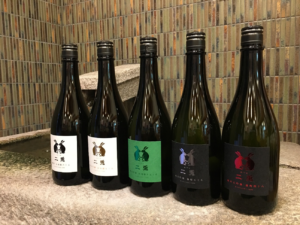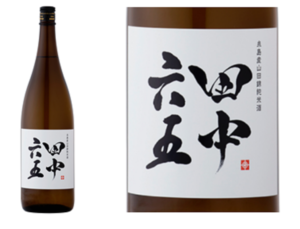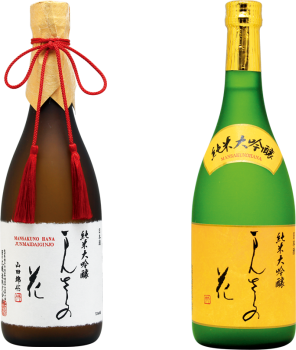
“MANSAKU NO HANA” is brewed in Yokote-city, Akita Prefecture.
Contents
How “MANSAKU NO HANA” was born
“MANSAKU NO HANA'' was launched in 1980 by Hinomaru Sake Brewery in Yokote City.
The development of the sake was based on the NHK morning TV series “Mansaku-no-Hana” being filmed in the area, which created interest in the local community to create a sake based on the drama. The momentum led to the Hinomaru brewery’s development and release of the namesake sake in response.
Witch hazel (Mansaku: マンサク) was traditionally very popular as a spring heralding flower in the local area. The predecessor (Mitsuo Sato), who was born in the mild climate of Shizuoka, also loved witch hazel, which bloomed early in spring without breaking, even under heavy snowfall.
He was also encouraged by his friendship with Ai Sasaki (the present leader of the Bunka-za Theater), and the late Jukichi Uno, both of whom acted in the drama.
However, those were still the days of the sake grading system where sake was clasified by alcohol content such as “special”, “first”, and “second”. The Hinomaru brewery, following the system, released a second grade sake under the name “KI MANSAKU”, while commercializing a high-grade sake of Special Ginjo with the label of “MANSAKU NO HANA” which is still used today.
When the grading system was abolished in 1992, the sake industry entered a period of rapid change. "After 1993, the production of high-end sake came to be more focused, and “MANSAKU NO HANA” was a forerunner of this change.
"It’s not unusual for people to move on from the products made in collaboration with TV dramas when the show ends, but I believe our effort of pursuing genuine, high value-added products has led to today's MANSAKU NO HANA," says Mr. Sato, Senior Managing Director. As he said, "MANSAKU NO HANA" has become one of the representatives of the ginjo-shu line that makes the most of local characteristics.
What kind of flower is “ witch hazel”?
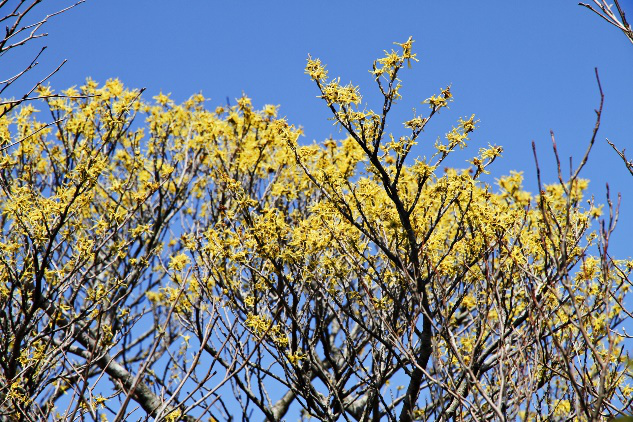
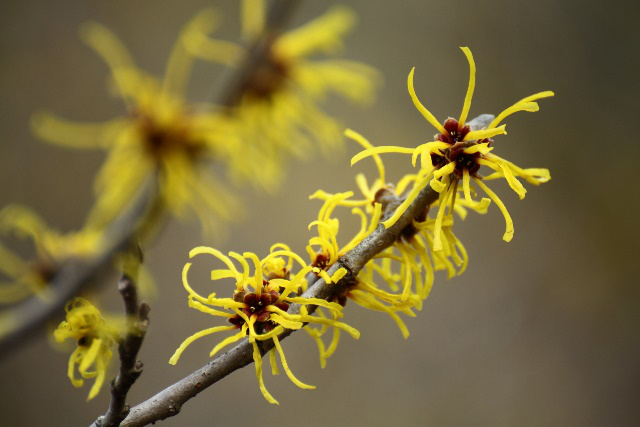
A small deciduous tree of the Witch hazel family. (Latin name: Hamamelis japonica)
The witch hazel blossom blooms in February and March, before the leaves emerge. Some say the name of “Mansaku(マンサク)“came from a Japanese phrase of “まず咲く(mazu saku)or ”まんず咲く(manzu saku)in Tohoku dialect meaning “first to bloom”. Others say the appearance of a large number of flowers leads to a productive harvest, known as “万年豊作 mannen housaku” in Japanese.
For the people of Akita prefecture, known for its heavy snowfall, the arrival of spring is a joyous occasion. Witch hazel is beloved as a good omen for a good harvest.
You sometimes see the red and white flowers found in Western witch hazel. However, it is said that yellow is the color which attracts pollinating insects when there is still snow on the ground, and that therefore the abundance of yellow is a survival strategy of the plant (Reference: Website of Akita Forest Growing Activity Support Center).
The flower language is "inspiration" and "mystery”.
In Japanese culture, occasionally flowers are associated with Japanese words that are said to describe the flower's appearance or properties.
Regarding the witch hazel, the word "inspiration" is derived from the fact that the petals are curled into a thin line, and when they burst open, they look like an "inspiration”.
The “mystery” is said to have come from the fact witch hazel trees were used for fortune-telling as they possessed "mystical" powers. (flower language and origin: https://hananokotoba.com/).
"MANSAKU NO HANA" can be said to be the sake that carries the meaning of the language of flowers.
About the typeface

The thin lines and flowing kana characters are eye-catching among sake labels with many solid sumi ink characters.
It was written by calligrapher Ms. Shichiku Imazeki*1.
The younger sister of the current president of Hinomaru Sake Brewery studied under her instruction, which led to the development of this typeface.
It gives a perfect impression of "clean and gentle sake quality".
Note 1:Imazeki Shichiku, real name: Saeko Imazeki - the wife of the great calligrapher Osamu Imazeki (1909-1989), who served as a calligraphy instructor until his death when the current Emperor was Prince Hironomiya.
About the label
The labels are fun!
Mr. Sato says they cared about labels because he wanted people to enjoy sake both from the taste and the sight.
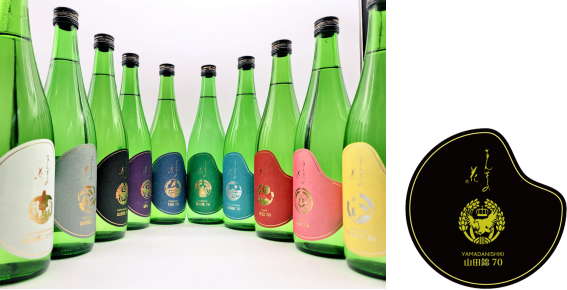
First is the "Junmai(巡米)" series.
Usually, Junmai is written as “純米“ with a kanji ”純“ meaning “pure”, but they dared to use a kanji of “巡” meaning “travel around”. As the kanji suggests, you can “travel around”, enjoying different characteristics of the sake released every month. The varieties of rice used to make the sake is illustrated below.
Did you also notice the shape of the label is "rice"?

A unique type of rice is called Hyakuden. This is a sake rice newly developed by Akita Prefecture, and full-scale shipments just began in 2021. It has a reputation for being as suitable for sake brewing as Yamada Nishiki.
The Misato Nishiki variety is also to be noted. It was developed in Akita Prefecture in 2002 from the two superstars of sake rice, Yamada Nishiki (No. 1 in production) and Miyama Nishiki (No. 3), and it yields different but attractive tastes from its parent rice.
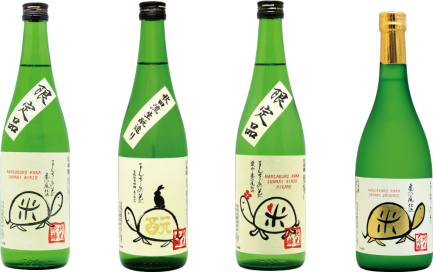
The Kame (turtle) series is junmai-shu made from a sake rice called "Kame-no-o". The turtle illustration is adorable.
There are also other fun products to look at and choose from, such as the Ultimate Drink Tasting Series, which allows you to enjoy the sake created by the pressing method: Arabashiri, Nakagumi, and Seme, and the MX Series, which is designed for pairing with Western cuisine.
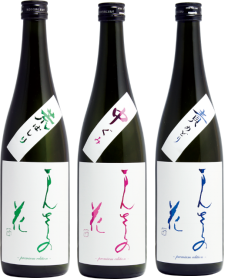

About Hinomaru Sake Brewery

Hinomaru Sake Brewery was founded in 1689 by Jinbei Kutsuzawa, a native of Uzen Province (present-day Yamagata Prefecture). The name of the brewery, Hinomaru, is said to have been named after the five-pillared fan with a sun*2, which was the official crest of Lord Satake of the Akita domain.
This was before Hinomaru became a symbol of Japan.
Note 2: The family crest of the Satake family, which is descended from the Minamoto clan. It is generally called the "Hinomaru” fan.
In the early Showa period (1926-1989), the company was one of the largest sake breweries in the Tohoku region, but it was closed down due to the Industrial Control Order during World War II. In 1948, the company was revived by the late Mitsuo Sato (from Shizuoka Prefecture) with some ups and downs, finally fully returning in 1980 with "MANSAKU NO HANA”.
They currently have 16 employees, 40% of whom are in their 20s. This is the generation that will carry forward the future of sake brewing.
It is noteworthy that Hinomaru Sake Brewery is not only a sake brewer, but also a pioneer in "work style reform”. They are putting as much energy into eliminating overtime and increasing annual leave as they put into sake brewing. This is probably because they believe that improving the working environment will lead to "good sake," "sake that pleases people," and "sake that people enjoy.”
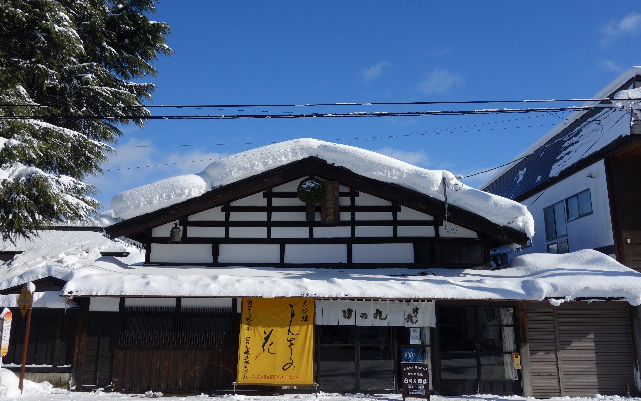
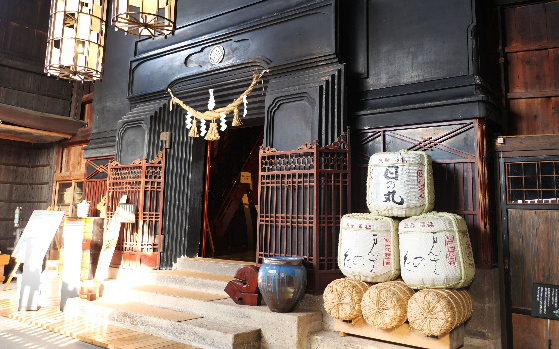
"I want to lower the bar for sake, to make it more fun, and for people to enjoy it without thinking about complicated things... I want people to drink a variety of "MANSAKU NO HANA" without saying that they know it because they drank it once. I would like people to try various kinds of "MANSAKU NO HANA. But you won't complete the series, unless you drink one every month (laughs)..."
This is a message from Mr. Koji Sato, the next generation.
Interview cooperated by: Mr. Koji Sato, Senior Managing Director, Hinomaru Sake Brewery
Interview date: September 22, 2021
Image data presented by: Hinomaru Sake Brewery
Post Interview: Mr. Koji Sato of the Hinomaru was a young executive director with a gentle manner. But what impressed me even more was his enthusiasm to improve the working environment of the company. He talked passionately about what he had done and what he is aiming for.
I am sure that the sake produced at such a brewery will taste even better. I am looking forward to it.

